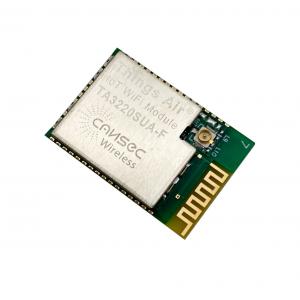Product Details
Low Cost Transparent AT Command Wifi Module Cansec TA3220SSA-F Ti
CC3220 Smart Home Wifi Wireless Transceiver Module
Parameter | Min | Typ | Max | Unit |
Current
Consumption | Sleep Mode(For Hibernate) | - | - | 9 | uA |
| Transmit Mode (@18dbm,for carrier) | - | 400 | 450 | mA |
TX Power (For Carrier) | - | 17 | 20 | dBm |
RX Sensitivity | - | - | -96 | dBm |
Distance | 190 | m |
Low Cost Transparent AT Command Wifi Module Cansec TA3220SSA-F Ti
CC3220 Smart Home Wifi Wireless Transceiver Module
1. TA3220S Module is designed based on TI’s CC3220S which is part of
the SimpleLink™ microcontroller (MCU) platform, which share a
common, easy-to-use development environment with a single core
software development kit (SDK) and rich tool set. A one-time integration of the SimpleLink platform enables you to
add any combination of the portfolio’s devices into your design,
allowing 100 per cent code reuse when your design requirements
change. For more information, visit Overview for SimpleLink™
solutions.
2. Start your Internet-of-Things (IoT) design with a Wi-Fi® CERTIFIED®
single-chip MCU System-on-Chip(SoC) with built-in Wi-Fi
connectivity. Created for the IoT, the SimpleLink™ CC3220x device
family from Texas Instruments™ is a single-chip solution,
integrating two physically separated, on-chip MCUs. • An application processor – ARM®
Cortex®-M4 MCU with a user-dedicated 256KB of RAM, and an optional
1MB of XIP flash. • A network processor MCU to run all Wi-Fi and
Internet logical layers. This ROM-based subsystem includes an
802.11b/g/n radio, baseband, and MAC with a powerful crypto engine
for fast, secure internet connections with 256-bit encryption.
3. The CC3220x wireless MCU family is part of the second generation of
TI’s Internet-on-a-chip™ family of solutions. This generation
introduces new features and capabilities that further simplify the
connectivity of things to the Internet. The new capabilities
including the following:
• Enhanced Wi-Fi provisioning • Enhanced power consumption
• Enhanced file system security (supported only by the CC3220S and
CC3220SF devices) Wi-Fi AP connection with up to four stations • More concurrently opened BSD sockets; up to 16 BSD sockets, of
which 6 are secure
• HTTPS support
• RESTful API support
• Asymmetric keys crypto library
• The CC3220x wireless MCU family supports the following modes:
station, AP, and Wi-Fi Direct®. The device also supports WPA2
personal and enterprise security. This subsystem includes embedded
TCP/IP and TLS/SSL stacks, HTTP server, and multiple Internet
protocols. The device supports a variety of Wi-Fi provisioning
methods including HTTP based on AP mode, SmartConfig™ Technology,
and WPS2.0.
• The power-management subsystem includes integrated DC-DC
converters that support a wide range of supply voltages. This
subsystem enables low-power consumption modes for extended battery
life, such as low-power deep sleep, hibernate with RTC (consuming
only 4.5 μA), and shutdown mode (consuming only 1 μA).
• The device includes a wide variety of peripherals, including a
fast parallel camera interface, I2S, SD, UART, SPI, I2C, and
4-channel ADC.
FAQ
Q1: Are you a factory or trade company?
A1: We are a professional factory with 25 years experience.
Q2: Can you accept OEM/ODM?
A2: Sure, we have rich OEM&ODM experience.
Q3: Do you have quality assurance?
A3; Each of our products has undergone quality testing and has two
years of free after-sales service.
Most Important WiFi TerminologyNow that we’ve explained what WiFi
stands for and provided you with a widely accepted WiFi definition,
it’s time to take a closer look at some of the most important WiFi
terminology. As you can probably imagine, we can only scratch the
surface of the IEEE 802.11 standard here, but knowing the terms
described below should be enough to help you make wise purchasing
decisions when buying a new Wifi router or selecting a new internet
providerWi-Fi Radio SpectrumAs we’ve already mentioned, WiFi is
transmitted at the 2.4 GHz and 5 GHz frequencies. In North America,
the 2.4 GHz band is divided into 11 channels, with channels 1, 6,
and 11 being non-overlapping. The 5 GHz band is divided into a much
larger number of channels, with each country applying its own
regulations to the allowable channels.The biggest difference
between the two frequency bands is the fact that the 5 GHz signal
is only about half the range of the 2.4 GHz signal. What’s worse,
it has more trouble penetrating walls and solid objects. On the
other hand, the 5 GHz band is far less crowded than the 2.4 GHz
band, which is a huge advantage in heavily populated urban areas
where WiFi networks are virtually everywhere.
Company Profile
We are Beijing JiaAn Electronics Technology, founded in 1994;
Taiwan invested.
We are the third-party partner of Texas Instruments and the
supplier of Arrow Electronics;
along with over 25 years of experience in the RF industry,
we developed a team with deep technical background,
high performance and quick response timing to co-operate with our
clients globally.
About 70 per cent of our clients are overseas, and 80 per cent of
our clients are returning customers.
All our products require layers and layers of inspections, testing
and quality control procedures before shipping;
Offering our client a trustworthy and long-lasting partnership.



